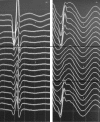Anatomical, clinical and electrical observations in piriformis syndrome
- PMID: 20180984
- PMCID: PMC2828977
- DOI: 10.1186/1749-799X-5-3
Anatomical, clinical and electrical observations in piriformis syndrome
Abstract
Background: We provided clinical and electrical descriptions of the piriformis syndrome, contributing to better understanding of the pathogenesis and further diagnostic criteria.
Methods: Between 3550 patients complaining of sciatica, we concluded 26 cases of piriformis syndrome, 15 females, 11 males, mean age 35.37 year-old. We operated 9 patients, 2 to 19 years after the onset of symptoms, 5 had piriformis steroids injection. A dorsolumbar MRI were performed in all cases and a pelvic MRI in 7 patients. The electro-diagnostic test was performed in 13 cases, between them the H reflex of the peroneal nerve was tested 7 times.
Results: After a followup 1 to 11 years, for the 17 non operated patients, 3 patients responded to conservative treatment. 6 of the operated had an excellent result, 2 residual minor pain and one failed. 3 new anatomical observations were described with atypical compression of the sciatic nerve by the piriformis muscle.
Conclusion: While the H reflex test of the tibial nerve did not give common satisfaction in the literature for diagnosis, the H reflex of the peroneal nerve should be given more importance, because it demonstrated in our study more specific sign, with six clinical criteria it contributed to improve the method of diagnosis. The cause of this particular syndrome does not only depend on the relation sciatic nerve-piriformis muscle, but the environmental conditions should be considered with the series of the anatomical anomalies to explain the real cause of this pain.
Figures





References
-
- Yeoman W. The relation of arthritis of the sacro-iliac joint to sciatica, with an analysis of 100 cases. Lancet. 1928;2:1119–1122. doi: 10.1016/S0140-6736(00)84887-4. - DOI
-
- Freiburg AH, Vinke TA. Sciatica and the sacroiliac joint. J Bone and Joint Surg. 1934;16:126–36.
-
- Beaton LE, Anson BJ. The sciatic nerve and the piriformis muscle. Their interrelation and possible cause of coccygodynia. J Bone Joint Surg Am. 1938;20:686–688.
LinkOut - more resources
Full Text Sources

